Haworthia Plant: Caring for The Cactus Like Succulent

Haworthia plants are small flowering succulents that look like miniature cacti. Common types of Haworthias, such as the zebra Haworthia or Haworthia attenuata plants, are some of the easiest houseplants to care for. Haworthias are small cactus-like succulents that have clusters of pointed fleshy green leaves that grow in a rosette shape. Similar to other succulents, these low-growing plants need plenty of light and little moisture.
How to care for Haworthia succulents: Haworthia plants thrive in bright indirect sunlight when growing in well-draining cactus soil. Water Haworthia plants when the soil dries and keep humidity levels average. These plants thrive in temperatures between 65°F and 80°F (18°C – 26°C). Fertilize occasionally during summer.
There are around 150 species of Haworthia plants which are in the plant family Asphodelaceae. Common Haworthia species include the Haworthiopsis fasciata (Zebra plant) with striped spiky leaves, the small Haworthia angustifolia, the Haworthia retusa (Star cactus), and the Haworthia bayeri with fleshy leaves and spectacular markings.
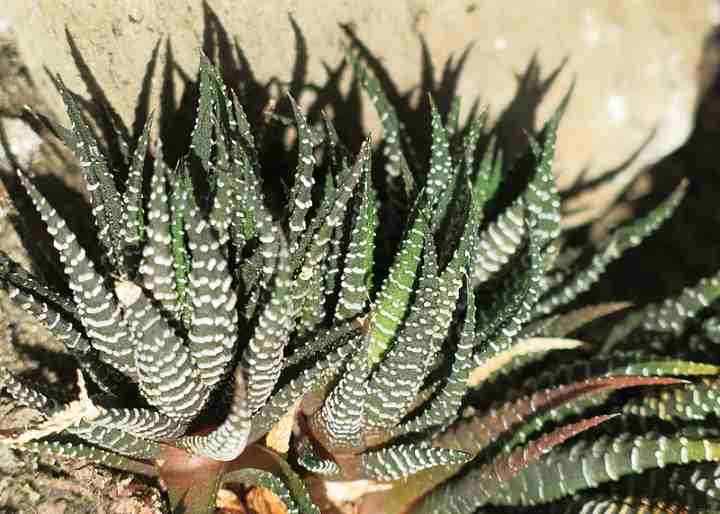
Haworthiopsis fasciata (zebra plant or Haworthia fasciata)
Many types of small Haworthia succulents have white bands, stripes, dots, or bumps on their fleshly leaves, giving them a distinct appearance. Because of their plump, fleshy leaves, and rosette shape, it’s easy to mistake Haworthia succulents for small aloe plants.
This article is a complete care guide about how to care for Haworthia succulents. Additionally, at the end of the article, you’ll find out how to resolve some issues with Haworthia plant care.
How to Grow Haworthia
Haworthia is an easy plant to grow indoors. Usually, the best way to grow all succulents, including Haworthia, is to give them plenty of sunlight and occasional watering. In many ways, growing Haworthia plants is similar to caring for aloe plants or species of Echeveria.
Haworthia Flowers
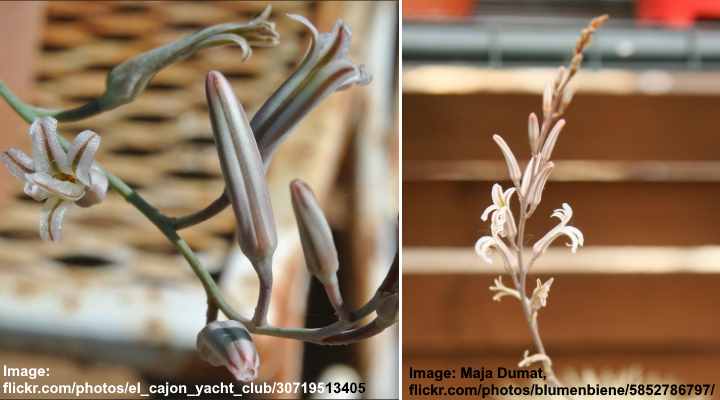
Haworthia fasciata flowers
Haworthia succulents flower in the spring or summer. The dainty white flowers appear on the end of long stalks. For Haworthia to flower regularly indoors, growing conditions must be optimal. This means plenty of warm sunshine in the summer and then cool, dry conditions in winter.
Haworthia Succulent Care Guide
Let’s look in more detail at how to care successfully for Haworthia plants at home. Although these mini succulents are low-maintenance plants, there are a few things you need to get right.
Light Requirements of Haworthia
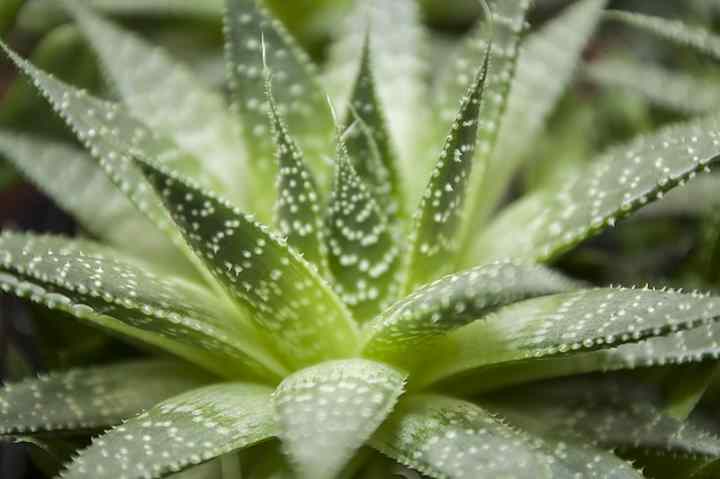
Haworthia succulents grow well in a bright indirect light
Haworthia plants thrive in bright, indirect sunlight. The best location for plants such as zebra plants or Haworthia fasciata is on an east or west-facing windowsill. Haworthia also grows well near a south-facing window as long as you protect it from the sun’s intense rays.
Similar to other succulents and cacti, Haworthia can grow in partial shade. Even if your room doesn’t have lots of natural light, a zebra cactus will still grow in low light in offices and north-facing rooms. However, succulents that grow in constant shade have weaker growth, and their deep green colors may fade.
As a general rule, a Haworthia’s growth is always best in bright, warm conditions.
One thing to keep in mind with caring for Haworthia species is that intense sunlight—such as midday sun—can damage the thick, fleshy leaves. Signs of too much sunshine are yellowing leaves or leaves that turn brown.
The Best Soil Type for Growing Haworthias
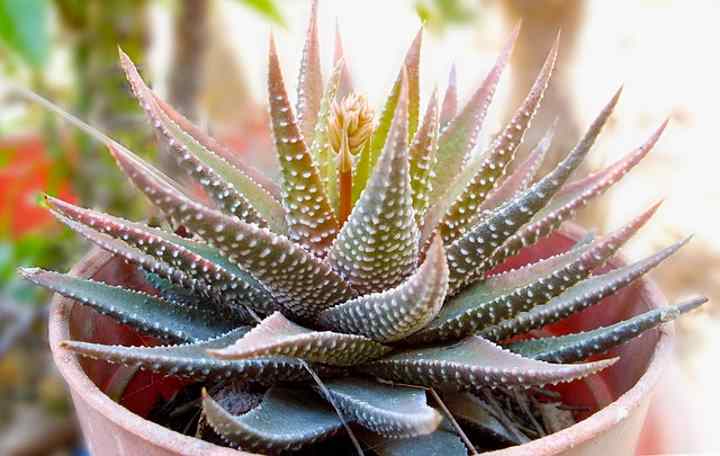
To care properly for your Haworthia succulent, make sure to plant it in a well-draining soil
Haworthia succulents grow best in a well-draining cactus potting mix. To create the ideal growing medium for Haworthia succulents, mix potting soil with perlite, pumice, or small pieces of gravel. These soil amendments aerate the growing medium and prevent water from making the soil too damp.
Haworthia fasciata (zebra succulents) don’t survive in soggy, overly-moist soil. This type of wet soil causes root rot, and the small houseplant will eventually die. Similarly, saturated soil can affect Haworthia growth if there are no drainage holes in the pot.
You can tell if your Haworthia soil is right by how fast it dries out. Under normal conditions, the potting mix should dry out in one to three weeks after watering. An ideal combination for growing succulents and cactus plants is equal amounts of potting soil and non-absorbent substances.
Some suitable soil amendments for a Haworthia potting mix include the following:
- Perlite
- Aquarium gravel
- Poultry grit
- Horticultural pumice
- Coarse horticultural sand
How Often to Water Haworthia Succulents
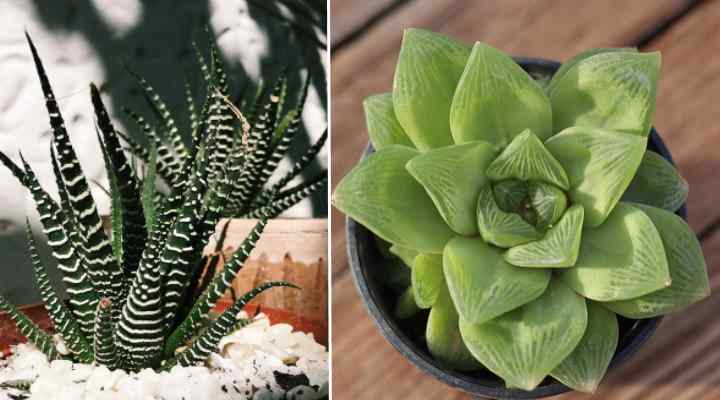
Haworthia succulents only need watering when the soil dries out. In the picture: Haworthia fasciata (left) and H. Cooperi (right)
Haworthia plants need watering as often as the potting mix dries out. To water succulents, thoroughly drench the soil. Then wait for a week or more before checking to see if the Haworthia needs watering again. In winter, you only need to water these succulent plants every other month.
When watering a zebra Haworthia or other succulent species, don’t be afraid to soak the soil. Deep watering hydrates the roots and helps the small plant absorb enough moisture. However, you should allow the soil to dry before watering again.
Remember that a succulent growing in dry or slightly damp soil is better than letting it sit in prolonged wet soil.
Rather than water these succulent plants on a regular schedule, only water when the soil is dry. This is because various factors affect how often a Haworthia needs watering. These factors include the following:
- Type of pot—Moisture evaporates faster from terracotta pots than plastic ones.
- Growing conditions—Succulents that grow in hot, arid conditions in summer need more frequent watering than in winter.
- Size of succulent—Small succulents such as Haworthia need less water than larger aloe plants.
Related reading: How to water houseplants properly.
Haworthia Fertilizer Needs
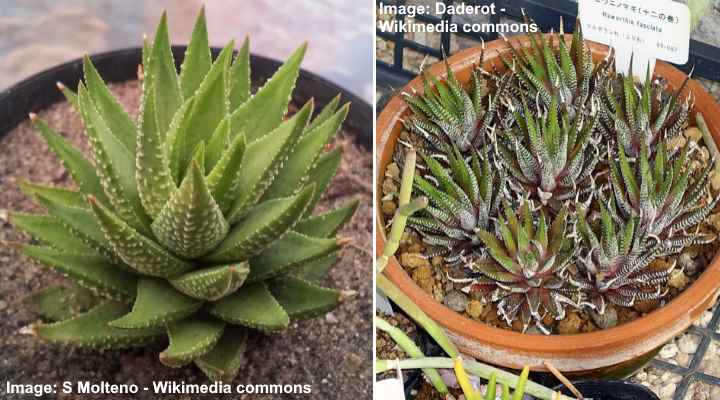
Haworthia succulents don’t need much feeding
Haworthia species don’t require much feeding. If you decide to fertilize these succulents, use a cactus balanced fertilizer that’s diluted to at least half-strength. You can apply fertilizer three times in the season—in spring, early summer, and late summer. Avoid fertilizing Haworthia in winter when they stop growing.
The essential element for Haworthia growth is nitrogen. So, an ideal fertilizer should have an N-P-K ratio of 3:1:2. But in many cases, succulents grow for many years without much care or feeding.
Related reading: The best houseplant fertilizers.
Ideal Temperature for Haworthia Care
Haworthia succulents like warm temperatures. Growing indoors, zebra succulents love average room temperatures between 65°F and 80°F (18°C – 26°C). During winter in the dormant period, around 50°F (10°C) is excellent for the plants. The minimum temperature for growing Haworthia is 40°F (4°C).
If you keep Haworthia succulents on a bright windowsill, you shouldn’t have to worry about the temperature. When the temperature is hot or the plants are in strong sunlight, make sure there is plenty of airflow. Good air movement helps the succulents to grow well without retaining too much moisture.
Haworthia Humidity Requirements
Haworthia needs low humidity to grow well. When growing as a houseplant, average household humidity is ideal for healthy haworthia growth. If you live in a humid environment, then increase air circulation around the plants. Too much humidity can cause moisture issues with Haworthia succulents and cause root rot.
Although Haworthia likes colder temperatures during winter, it’s vital to ensure that there’s no humidity. The combination of cold temperatures and high humidity can cause succulents such as Haworthia fasciata and Haworthia attenuata to die.
How to Repot Haworthia Plants
Haworthia species are slow-growing houseplants that rarely need repotting. You can repot zebra succulents every two to three years. The reasons for repotting are to refresh the potting mix, allow more room for growth, or separate roots for propagating. Always repot Haworthia plants in spring when growth is vigorous.
To repot Haworthia succulents, remove the plant from the pot. Using a sharp clean knife, separate any offshoots from the ‘mother’ plant. Shake off excess dirt from the roots and prune off any dead roots. Take a pot one size larger than the existing one and fill it three-quarters full with a well-draining cactus mix. Plant the succulent and fill the remaining space in the pot.
How to Propagate Haworthia Succulents
The easiest ways to propagate Haworthia succulents are by removing offsets (pups) or rooting cut leaves. Haworthia propagation is straightforward because pups grow around the ‘mother’ plant. All that’s necessary is to separate the offsets and plant in fresh potting soil. Or, a cut leaf will root and grow in soil.
To propagate Haworthia succulents with offsets:
- Remove the succulent from its pot.
- Gently shake the plant to see if any pups fall off by themselves.
- If not, use a sterilized knife to cut off the pups, making sure there are roots on the offsets.
- Let the ‘wounds’ on the mother plant and pups dry in fresh air for a few days.
- Plant the new plants in fresh, moist potting soil and wait until the soil dries before watering thoroughly.
To propagate Haworthia succulents from leaves:
- Use a sterilized knife to cut a fleshy leave from a Haworthia
- Leave the cut leaves on a paper towel for two to three days to dry out and allow the ‘wounds’ to callus over.
- Plant the cut leaf in a well-draining potting mix where it will take a few weeks to take root.
Pests Affecting Haworthia Succulent Growth
Common pests that can affect Haworthia fasciata and other species are mealybugs, spider mites, and scale insects. Pest infestations can affect the plant’s appearance and ultimately lead to death. Identifying signs of plant pests and eradicating them fast is vital for the health of your Haworthia.
To spot pests that can lurk in the tightly packed, spiky succulent leaves, this is what you should look out for:
- Mealybugs—Look for a white fuzzy substance like cotton wool on the fleshy leaves. You can also spot mealybugs as small white bugs crawling in the crevices between succulent leaves.
- Spider mites—The tell-tale sign of spider mites is webbing on the succulent’s foliage. Because spider mites are so tiny, you’ll have difficulty spotting the pests on your plants.
- Scale insects—Scales are hard to spot on succulents because the pests rarely move. You can identify scale as an unusual growth on the succulent leaves. Use a cotton swab and rubbing alcohol to remove scale insects.
Use a neem solution or insecticidal soap to get rid of pests from Haworthia succulents.
Related reading: How to get rid of houseplant bugs naturally.
Diseases Affecting Haworthia Succulents
Like all succulents, Haworthia species are susceptible to root rot. Too much moisture in the soil causes succulent roots to decay and develop fungal diseases. Over time, the disease in the plant’s roots can spread to the stem and result in the plant dying.
Fungal disease caused by root rot in Haworthia plants is easy to prevent. The proper plant watering techniques are crucial for preventing plant disease. Only water haworthia succulent as often as the soil dries out. When you water, give the potting mix a good soaking and allow all the excess to drip out.
Signs that Haworthia plants have diseased roots include dried leaves, poor growth, or small unhealthy-looking leaves. If you notice any of these signs, it’s vital to check the plant’s roots for signs of damage. Remove any brown, soft stems and also trim off any dark-colored leaves.
Are Haworthia Plants Poisonous?
Zebra Haworthia succulents are not toxic to cats, dogs, or any other household pets. The ASPCA lists Haworthia on its list of non-toxic houseplants.
Varieties of Haworthia succulents
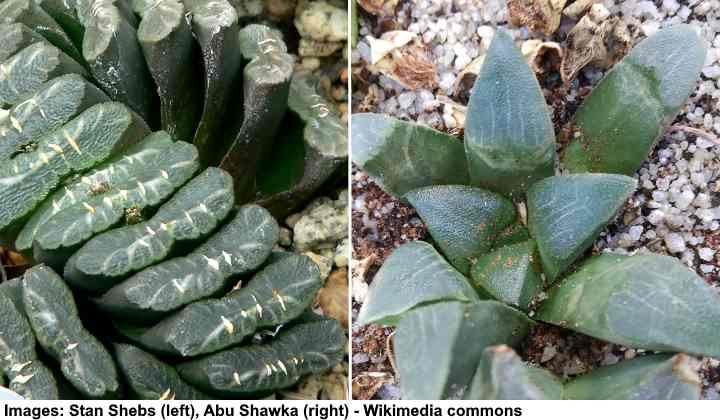
Haworthia truncata (left) and Haworthia bayeri (right)
The Haworthia species are some of the most popular types of succulents to grow indoors. Their deep green-colored leaves, white markings, and spiky appearance make Haworthias fascinating plants to grow. Most people choose succulents based on their form and markings.
Here are a few outstanding Haworthia examples:
- Haworthia fasciata – The famous “zebra plant” has dark green pointed leaves and horizontal white stripes on one side of its leaves.
- Haworthia bayeri – This succulent has fleshy triangular leaves with rounded ends.
- Haworthia attenuata – Also called the zebra Haworthia, this has white bands on both sides of the leaves, which distinguish it from the Haworthia fasciata.
- Haworthia truncata – Commonly named ‘horse’s teeth,’ the fascinating succulent has greenish succulent leaves that are rectangular.
- Haworthia Cooperi – A small rare succulent plant with fleshy translucent leaves that can be triangular-shaped or globular, depending on the cultivar.
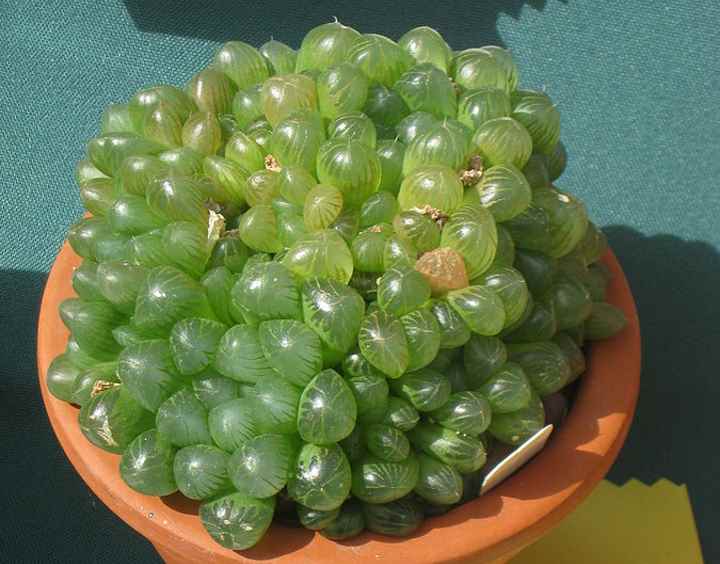
Haworthia cooperi ‘Truncata’ has shiny transparent round leaves
Related: Haworthia Fasciata (Zebra Haworthia): Succulent Care and Growing Guide
FAQs about Haworthia Succulent Care
Although Haworthia succulents are easy-care houseplants, there are a few issues that can affect their growth. Here are a few reasons why your succulent plants could be suffering.
Why is my Haworthia turning brown?
Too much intense sun or heat is often the reason for brown Haworthia succulent leaves. Strong sunlight scorches leaves, causing them to turn brown. If you notice that leaves are turning brown, move the small succulent away from direct sunlight. In time, the leaves should regain their dark green colors and unusual markings.
Why is my Haworthia succulent dying?
To revive a dying Haworthia plant, find the reason for its weak growth. Check the roots for signs of decay. If you spot root rot, save your plant by removing dead roots, then repot the succulent in fresh potting soil and reduce watering frequency.
If the roots look healthy and your haworthia plant seems that it’s dying, look for signs of pests. Eliminating plant pests with a simple insecticidal soap solution can be enough to revive a dying Haworthia.
How do you get a Haworthia to flower?
Haworthia succulents need the right growing conditions to flower indoors. To encourage blooming, keep the plants in the shade during winter and hold off watering. This gives Haworthia time to rest and get ready for growing again in the spring. Then when the temperature gets warmer, resume watering. As the days get longer and warmer, your Haworthia may produce small flowers in spring or summer.
Related: How to Grow Flowering Kalanchoe Succulents
Related articles:
